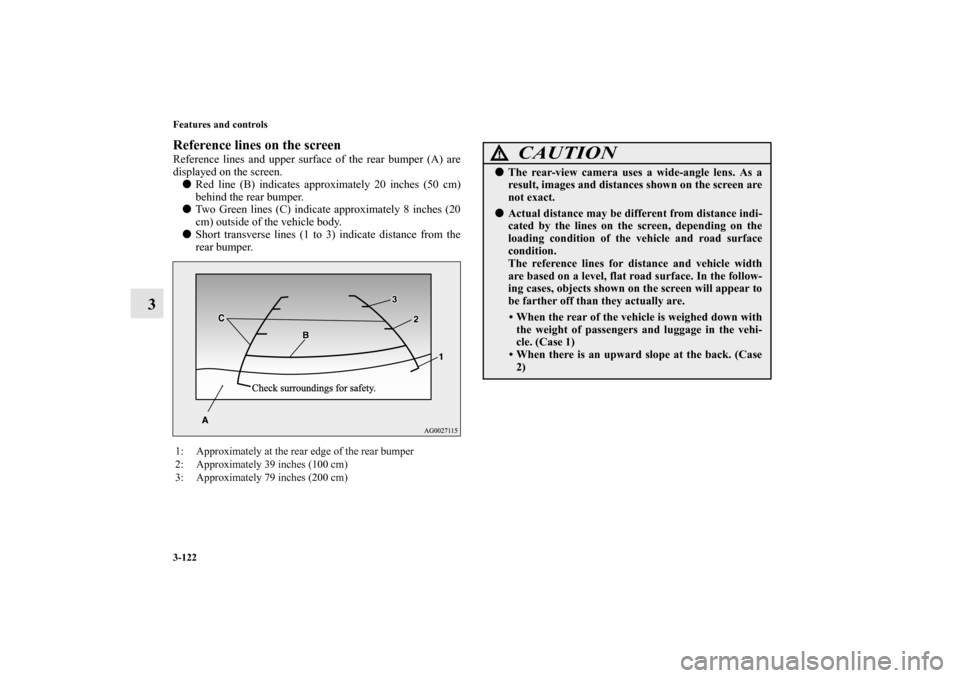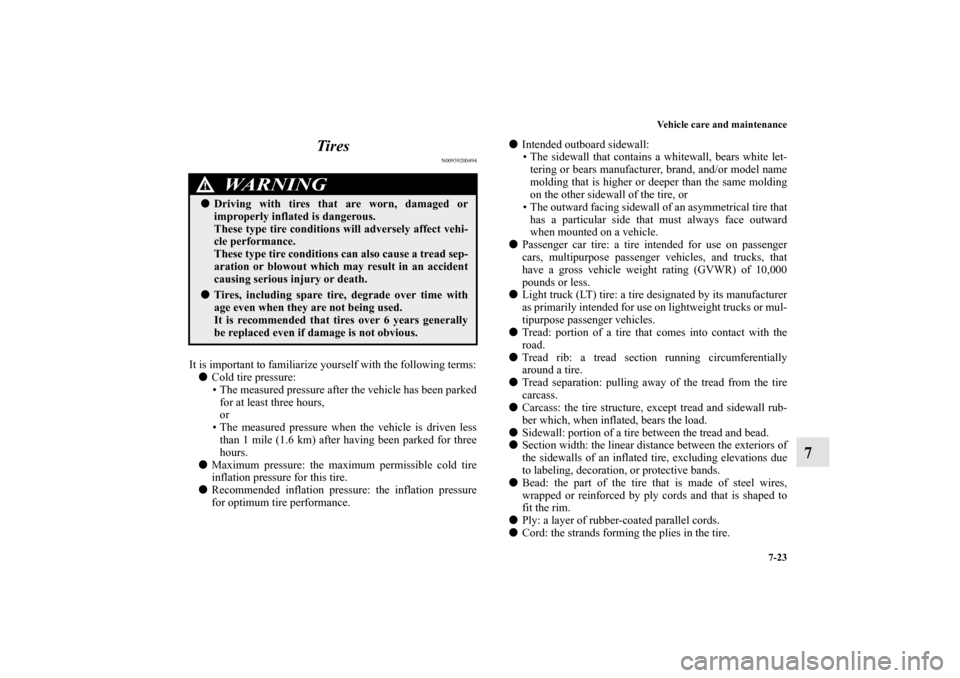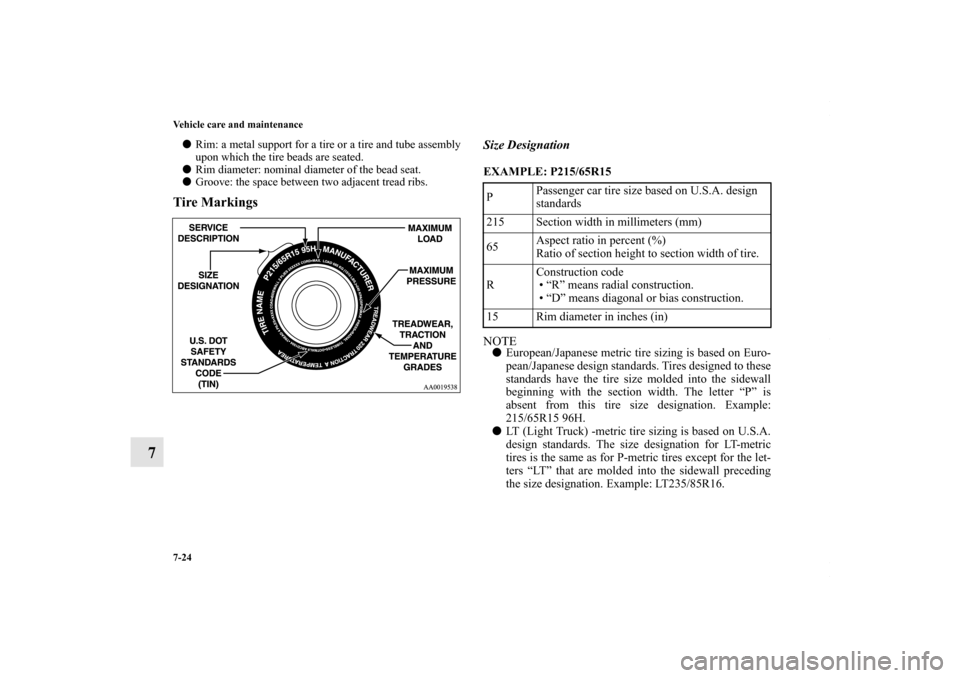Page 219 of 602

3-122 Features and controls
3
Reference lines on the screenReference lines and upper surface of the rear bumper (A) are
displayed on the screen. � Red line (B) indicates approximately 20 inches (50 cm)
behind the rear bumper.
� Two Green lines (C) indicate approximately 8 inches (20
cm) outside of the vehicle body.
� Short transverse lines (1 to 3) indicate distance from the
rear bumper.1: Approximately at the rear edge of the rear bumper
2: Approximately 39 inches (100 cm)
3: Approximately 79 inches (200 cm)
CAUTION
!�The rear-view camera uses a wide-angle lens. As a
result, images and distances shown on the screen are
not exact.�Actual distance may be different from distance indi-
cated by the lines on the screen, depending on the
loading condition of the vehicle and road surface
condition.
The reference lines for distance and vehicle width
are based on a level, flat road surface. In the follow-
ing cases, objects shown on the screen will appear to
be farther off than they actually are.
• When the rear of the vehicle is weighed down with
the weight of passengers and luggage in the vehi-
cle. (Case 1)
• When there is an upward slope at the back. (Case 2)
BK0150700US.book 122 ページ 2012年3月22日 木曜日 午後6時46分
Page 220 of 602
Features and controls3-123
3
A- Actual objects
B- Objects shown on the screen Case 1Case 2
A- Actual objects
B- Objects shown on the screen
CAUTION
!�The reference lines for distance and vehicle width
are intended to indicate the distance to a flat object
such as a level, flat road surface. They may not indi-
cate correct distance depending on the shape of an
obstacle.
For example, when there is an object behind the
vehicle that has upper sections projecting in the
direction of the vehicle, the reference lines on the
screen will indicate that point A is the farthest point
and point B is the closest point to the vehicle. In real-
ity, point A and B are actually the same distance
from the vehicle, and point C is farther off than
point A and B.
BK0150700US.book 123 ページ 2012年3月22日 木曜日 午後6時46分
Page 524 of 602

Vehicle care and maintenance7-23
7
Tires
N00939200494
It is important to familiarize yourself with the following terms:
� Cold tire pressure:
• The measured pressure after the vehicle has been parked for at least three hours,
or
• The measured pressure when the vehicle is driven less than 1 mile (1.6 km) after having been parked for three
hours.
� Maximum pressure: the maximum permissible cold tire
inflation pressure for this tire.
� Recommended inflation pressure: the inflation pressure
for optimum tire performance. �
Intended outboard sidewall:
• The sidewall that contains a whitewall, bears white let-
tering or bears manufacturer, brand, and/or model name
molding that is higher or deeper than the same molding
on the other sidewall of the tire, or
• The outward facing sidewall of an asymmetrical tire that has a particular side that must always face outward
when mounted on a vehicle.
� Passenger car tire: a tire intended for use on passenger
cars, multipurpose passenger vehicles, and trucks, that
have a gross vehicle weight rating (GVWR) of 10,000
pounds or less.
� Light truck (LT) tire: a tire designated by its manufacturer
as primarily intended for use on lightweight trucks or mul-
tipurpose passenger vehicles.
� Tread: portion of a tire that comes into contact with the
road.
� Tread rib: a tread section running circumferentially
around a tire.
� Tread separation: pulling away of the tread from the tire
carcass.
� Carcass: the tire structure, except tread and sidewall rub-
ber which, when inflated, bears the load.
� Sidewall: portion of a tire between the tread and bead.
� Section width: the linear distance between the exteriors of
the sidewalls of an inflated tire, excluding elevations due
to labeling, decoration, or protective bands.
� Bead: the part of the tire that is made of steel wires,
wrapped or reinforced by ply cords and that is shaped to
fit the rim.
� Ply: a layer of rubber-coated parallel cords.
� Cord: the strands forming the plies in the tire.
WARNING
!�Driving with tires that are worn, damaged or
improperly inflated is dangerous.
These type tire conditions will adversely affect vehi-
cle performance.
These type tire conditions can also cause a tread sep-
aration or blowout which may result in an accident
causing serious injury or death.�Tires, including spare tire, degrade over time with
age even when they are not being used.
It is recommended that tires over 6 years generally
be replaced even if damage is not obvious.
BK0150700US.book 23 ページ 2012年3月22日 木曜日 午後6時46分
Page 525 of 602

7-24 Vehicle care and maintenance
7
�Rim: a metal support for a tire or a tire and tube assembly
upon which the tire beads are seated.
� Rim diameter: nominal diameter of the bead seat.
� Groove: the space between two adjacent tread ribs.Tire Markings
Size DesignationEXAMPLE: P215/65R15
NOTE�European/Japanese metric tire sizing is based on Euro-
pean/Japanese design standards. Tires designed to these
standards have the tire size molded into the sidewall
beginning with the section width. The letter “P” is
absent from this tire size designation. Example:
215/65R15 96H.
� LT (Light Truck) -metric tire sizing is based on U.S.A.
design standards. The size designation for LT-metric
tires is the same as for P-metric tires except for the let-
ters “LT” that are molded into the sidewall preceding
the size designation. Example: LT235/85R16.P Passenger car tire size based on U.S.A. design
standards
215 Section width in millimeters (mm)
65 Aspect ratio in percent (%)
Ratio of section height to section width of tire.
R Construction code
• “R” means radial construction.
• “D” means diagonal or bias construction.
15 Rim diameter in inches (in)
BK0150700US.book 24 ページ 2012年3月22日 木曜日 午後6時46分
Page 588 of 602
Specifications9-5
9
Certification label
N01148200167
The certification label is located on the driver’s door sill.
Vehicle dimensions
N01147500479
Overall length 169.1 in (4,295 mm)Overall width 69.7 in (1,770 mm)Overall height
Without roof rails 64.2 in (1,630 mm)With roof rails 64.6 in (1,640 mm)
Wheel base105.1 in (2,670 mm)
BK0150700US.book 5 ページ 2012年3月22日 木曜日 午後6時46分